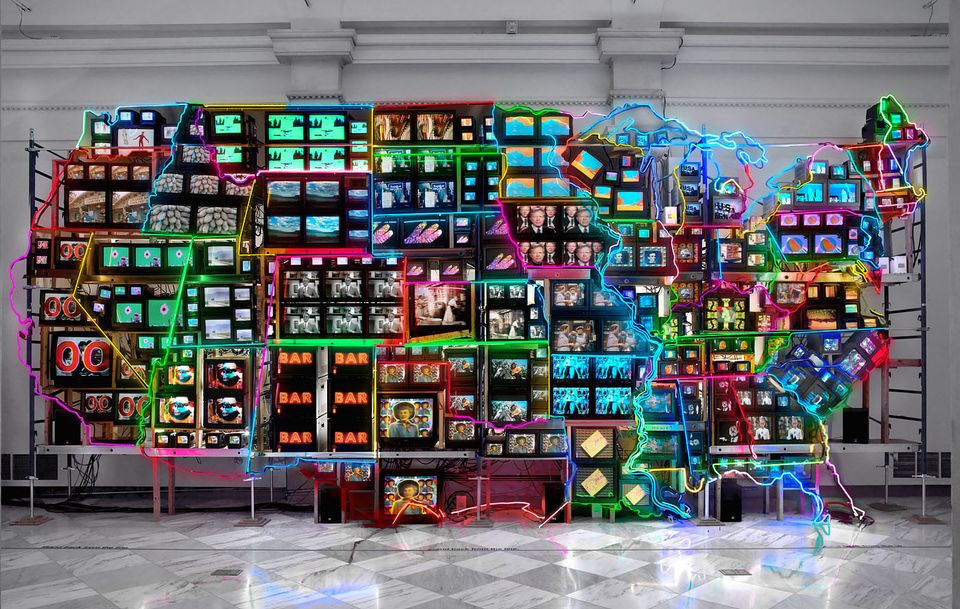
As I'm sure many readers know by now, the tremendous video and Fluxus artist Nam June Paik died last month at the age of 74. Of his many works that have been discussed both in the press and the blogosphere over the last two weeks, one especially comes to mind now that the winter Olympics have begun: the more the better. An installation comprising 1,003 screens, the work was staged in honor of the 1988 Olympics in Seoul.
The piece was a mutual tribute between Paik and his homeland. In shape and context, the more, the better is a media ziggurat that recalls Tatlin's similarly ambitious Third International Tower. Paik's giant resembles a towering birthday cake to the world—fitting for an artist who tapped visual sources and information streams from the many places he lived and studied, including Egypt, Germany, Hong Kong, Japan, and the United States. The piece also represented a homecoming for Paik, who was embraced by his native state after living abroad for nearly 20 years; the more, the better is an icon at the National Museum of Contemporary Art in Seoul, where it was first erected and is still displayed. The memorial photograph of a Paik portrait and wreath being laid before the work captures the nation's respect for its favorite son.
Growing up with emerging digital media, as opposed to growing into it, has definitely affected my impression of Paik's work. I don't remember the first piece I saw by him, but I remember seeing Video Flag for the first time and thinking that, as perceptive and visually aggressive as the piece was, it foretold a world that had not only arrived already, but had crystallized in the form of the Internet. No doubt, Paik showed striking prescience in coining "The future is now" and "electronic superhighway" well before even computer use was widespread, much less networking. But by the late 90s, when I came of age, both read like past tense to me—by that time, the world was simply inundated with information about information. And having since then seen dozens of magazine covers and read hundreds of articles on the engine of change that is the Internet—not to mention having written and immersed myself in blogs for the last 3 years—I don't feel like I'm ever far enough away from the neural nexus of the universe to casually or neutrally observe it.
But I think I was wrong about Paik, or at least that I came about his art from the wrong direction. Examples like the more, the better or Video Flag or Good Morning, Mr. Orwell (a globally transmitted broadcast of international video streams "conducted" by Paik) are less passive than I was first led to believe. For an artist to make predictions about global trends (and Paik perceived "real time" phenomena long before the same occurred to many others) and interrupt, mediating these changes as they happened—creating works that are, in an important sense, about the entire world—is a tremendous undertaking.
Yet in so doing, Paik never lost sight of his musical roots. Wrap Around the World was a transcontinental video performance coordinated by Paik, broadcast by satellite from 10 countries to millions of viewers and performed within a week of the 1988 Olympics unveiling of the more, the better. In Wrap Paik orchestrates dozens of performances around the conceit that an orbiting figure is monitoring the feeds to determine whether the planet should be destroyed—a cool allusion to science-fiction prognostications about advancing technology and also symbolic of the artist's own global perspective. Significantly, in this work Paik personally interjects in one video. He appears in traditional Korean garb with a birthday cake (like a little model of the more, the better) and says repeatedly, "Continue music," as if all the information and interconnectedness only served to further one man's orchestration.


















